人教版七年级下册英语Unit3Howdoyougettoschoo:SelfCheck(知能新视窗名师开小灶实战演练场能力提高)
2019-2020年人教版英语七年级下册Unit 3 How do you get to schoo
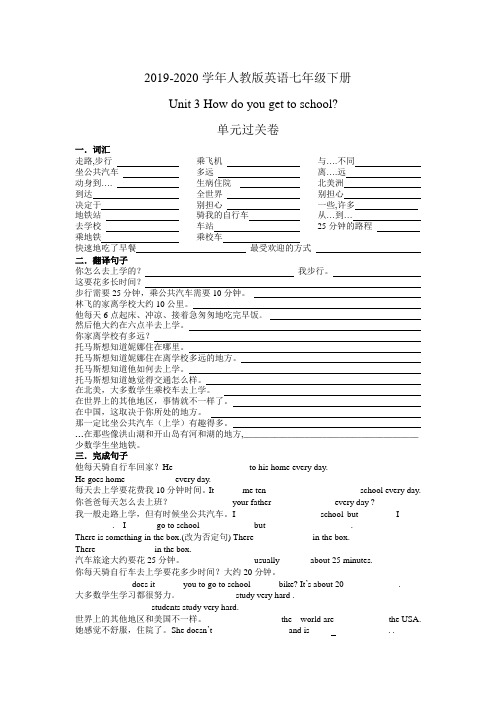
2019-2020学年人教版英语七年级下册Unit 3 How do you get to school?单元过关卷一.词汇走路,步行坐公共汽车动身到…. 到达决定于地铁站去学校乘地铁乘飞机多远生病住院全世界别担心骑我的自行车车站乘校车与….不同离….远北美洲别担心一些,许多___________ __从…到…_______ ______25分钟的路程快速地吃了早餐最受欢迎的方式二.翻译句子你怎么去上学的?我步行。
这要花多长时间?步行需要25分钟,乘公共汽车需要10分钟。
林飞的家离学校大约10公里。
他每天6点起床、冲凉、接着急匆匆地吃完早饭。
然后他大约在六点半去上学。
______________你家离学校有多远?托马斯想知道妮娜住在哪里。
托马斯想知道妮娜住在离学校多远的地方。
托马斯想知道他如何去上学。
托马斯想知道她觉得交通怎么样。
在北美,大多数学生乘校车去上学。
在世界上的其他地区,事情就不一样了。
在中国,这取决于你所处的地方。
那一定比坐公共汽车(上学)有趣得多。
…在那些像洪山湖和开山岛有河和湖的地方,________________________________________ 少数学生坐地铁。
_______________________________________________________________ 三.完成句子他每天骑自行车回家?He______ _____ _____ to his home every day.He goes home _____ _____ every day.每天去上学要花费我10分钟时间。
It______ me ten_____ _____ _____ _____school every day. 你爸爸每天怎么去上班?_______ _____ your father____ ____ _____ every day ?我一般走路上学,但有时候坐公共汽车。
人教版 七年级英语(下册) Unit 3 How do you get to school(2019年春)
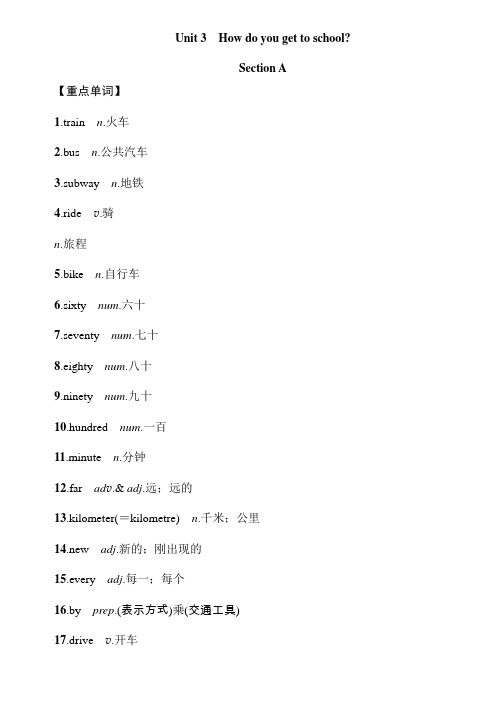
Unit 3How do you get to school?Section A【重点单词】1.train n.火车2.bus n.公共汽车3.subway n.地铁4.ride v.骑n.旅程5.bike n.自行车6.sixty num.六十7.seventy num.七十8.eighty num.八十9.ninety num.九十10.hundred num.一百11.minute n.分钟12.far ad v.& adj.远;远的13.kilometer(=kilometre)n.千米;公里14.new adj.新的;刚出现的15.every adj.每一;每个16.by prep.(表示方式)乘(交通工具)17.drive v.开车18.car n.小汽车;轿车19.live v.居住;生活【单词变形】1.bus—buses(复数)2.sixty—sixties(复数)3.far—near(反义词)4.live—living(现在分词)5.drive—driving(现在分词)—driver(名词)【重点短语】1.take the train乘火车2.take the bus乘公共汽车3.take the subway乘地铁4.ride a bike/by bike骑自行车5.every day每天6.get to school到达学校7.one hundred and five一百零五8.how far多远9.how long多长时间10.ride a bike to school骑自行车去上学11.have a good day度过愉快的一天【重点句型】1.——你如何去学校?——我骑自行车去学校。
—How do you get to school?—I ride my bike.2.乘公共汽车需要大约20分钟。
The bus ride takes about 20 minutes.3.这是不错的锻炼。
初中英语人教版七年级下册Unit 3 How do you get to scho
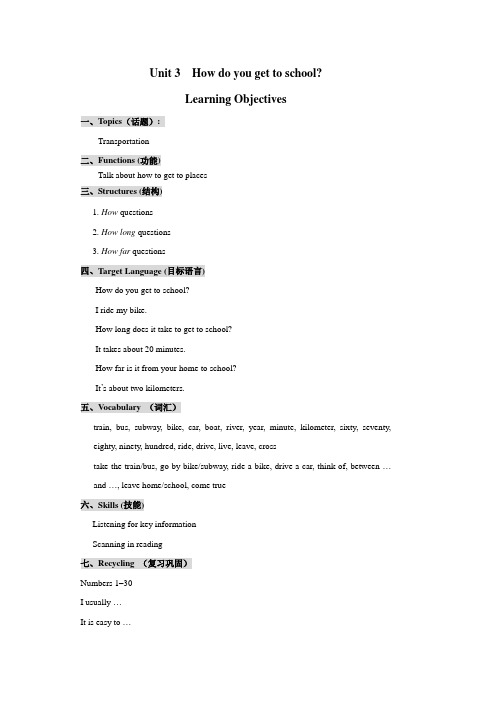
Unit 3 How do you get to school?Learning Objectives一、Topics(话题):Transportation二、Functions (功能)Talk about how to get to places三、Structures (结构)1. How questions2. How long questions3. How far questions四、Target Language (目标语言)How do you get to school?I ride my bike.How long does it take to get to school?It takes about 20 minutes.How far is it from your home to school?It’s about two kilometers.五、Vocabulary (词汇)train, bus, subway, bike, car, boat, river, year, minute, kilometer, sixty, seventy, eighty, ninety, hundred, ride, drive, live, leave, crosstake the train/bus, go by bike/subway, ride a bike, drive a car, think of, between …and …, leave home/school, come true六、Skills (技能)Listening for key informationScanning in reading七、Recycling (复习巩固)Numbers 1–30I usually …It is easy to …Thanks for …八、教材分析本单元以How do you get to school?为中心话题,主要运用How long/How far 询问“去某地的交通方式、时间、距离”,简单描述路线。
2019-2020年人教版英语七年级下册Unit 3 How do you get to schoo
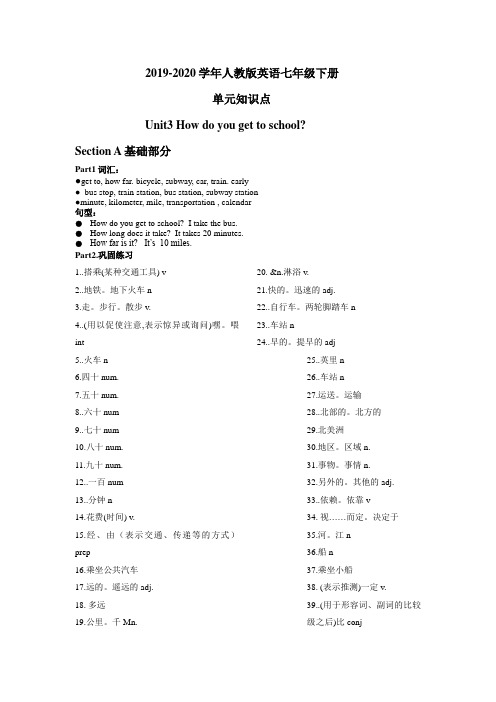
2019-2020学年人教版英语七年级下册单元知识点Unit3 How do you get to school? Section A 基础部分Part1词汇:●get to, how far. bicycle, subway, car, train. early● bus stop, train station, bus station, subway station●minute, kilometer, mile, transportation , calendar句型:●How do you get to school? I take the bus.●How long does it take? It takes 20 minutes.●How far is it? It’s 10 miles.Part2.巩固练习1..搭乘(某种交通工具) v2..地铁。
地下火车n3.走。
步行。
散步v.4..(用以促使注意,表示惊异或询问)嘿。
喂int5..火车n6.四十num.7.五十num.8..六十num9..七十num10.八十num.11.九十num.12..一百num13..分钟n14.花费(时间) v.15.经、由(表示交通、传递等的方式)prep16.乘坐公共汽车17.远的。
遥远的adj.18. 多远19.公里。
千Mn. 20. &n.淋浴v.21.快的。
迅速的adj.22..自行车。
两轮脚踏车n23..车站n24..早的。
提早的adj25..英里n26..车站n27.运送。
运输28..北部的。
北方的29.北美洲30.地区。
区域n.31.事物。
事情n.32.另外的。
其他的adj.33..依赖。
依靠v34. 视……而定。
决定于35.河。
江n36.船n37.乘坐小船38. (表示推测)一定v.39..(用于形容词、副词的比较级之后)比conj40. (用于构成部分形容词及副词的比较级)(比……)更。
初中英语人教版七年级下册《Unit 3 How do you get toschool Sectio

Step 4:listen and learn
1c. Listen and check the things that Mary wants to know
listen and fill in the blanks
1d.Listen again. How does Bob get to his grandparents’ home? Check (√) 1 or 2.
人教新目标英语七年级下册Unit3第2课时教学设计
课题
Sectioபைடு நூலகம் B 1a-1e
单元
Unit 3 How do you get to school?
学科
英语
年级
七年级下册
学习
目标
1.知识与技能
(1)Key vocabulary:stop, think of
(2) Target language:
Step5:Pair work
Make a dialogue betweenstudentsand a
teacher.
Step6:Listen and learn
1. Let students listen to the tape and know
about the main points of the passage.
识点。
课堂小结
1.To learn different kinds of transportation stops and stationsbus stop, train/bus/subway station...
2.To use How questions to talk about how to get to places (more than one type of transportation)
人教版七年级英语下册unit3(详细内容)
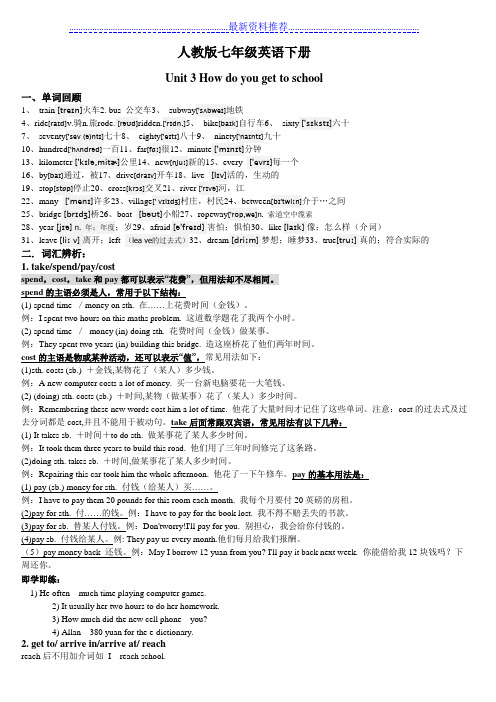
人教版七年级英语下册Unit 3 How do you get to school一、单词回顾1、train[treɪn]火车2. bus 公交车3、subway['sʌbweɪ]地铁4、ride[raɪd]v.骑n.旅rode. [rəʊd]ridden.['rɪdn.]5、bike[baɪk]自行车6、sixty['sɪkstɪ]六十7、seventy['sev (ə)ntɪ]七十8、eighty['eɪtɪ]八十9、ninety['naɪntɪ]九十10、hundred['hʌndrəd]一百11、far[fɑː]很12、minute['mɪnɪt]分钟13、kilometer['kɪlə,mitɚ]公里14、new[n juː]新的15、every ['evrɪ]每一个16、by[baɪ]通过,被17、drive[draɪv]开车18、live [lɪv]活的,生动的19、stop[stɒp]停止20、cross[krɔs]交叉21、river ['rɪvə]河,江22、many ['menɪ]许多23、village[' vɪlɪdʒ]村庄,村民24、between[bɪ'twiːn]介于…之间25、bridge[brɪdʒ]桥26、boat [bəʊt]小船27、ropeway['rop,we]n. 索道空中缆索28、year[jɪə]n. 年;年度;岁29、afraid[ə'freɪd]害怕;惧怕30、like [laɪk]像;怎么样(介词)31、leave [liː v]离开;left (lea ve的过去式)32、dream[driːm]梦想;睡梦33、true[truː]真的;符合实际的二. 词汇辨析:1. take/spend/pay/costspend,cost,take和pay都可以表示“花费”,但用法却不尽相同。
人教版七年级下册 Unit 3 How do you get to school
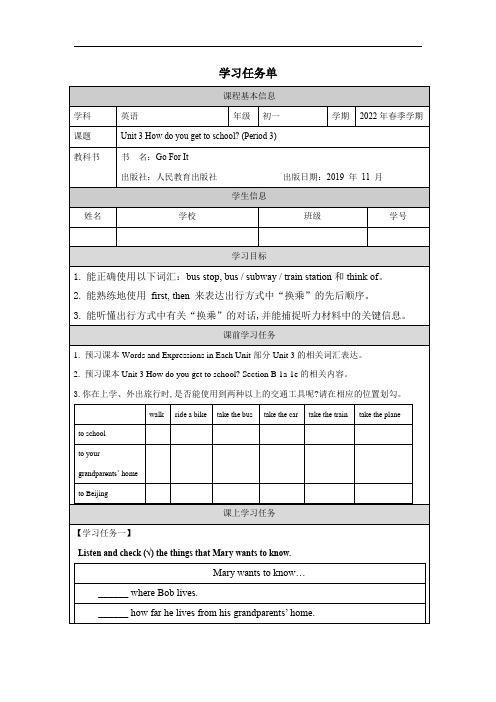
Talk about how Bob gets to his grandparents’ home.
A: How does Bob get to his grandparents’ home?
B:First, he _____________. Then ______________ from ____________ to _____________.
Mary: Oh, how far?
Bob: It’s about 500 kilometers from here.
Mary: Wow! That’s far.
Bob: Yes, it is. So I go there and see my grandparents only one or two times a year.
3.你在上学、外出旅行时,是否能使用到两种以上的交通工具呢?请在相应的位置划勾。
walk
ride a bike
take the bus
take the car
take the train
take the plane
to school
toyourgrandparents’home
to Beijing
课上学习任务
Mary: How do you get there?
Bob: I usually take the train.
Mary: How long does it take?
Bob:It takes about six hours. And then I take a bus from the train station to their home.
【学习任务七】
Summary:
2022年人教版七年级英语下册Unit 3 How do you get to school?per

4. It is not easy to cross the river on a ropeway, but
the boy is not __a__fr__a_i_d___.
Grossing the River to School
2b
Read
Grossing the River to School
How do you get to school? Do you walk or ride a bike? Do you go by bus or by train? For many students, it is easy to get to school. But for the students in a village in, it is difficult. There is a very big river between their school and the village. There is no bridge and the river runs too quickly for boats. So these students go on a ropeway to cross the river to school.
To have a bridge is their dream. I think so. People may raise lots of money to help them.
Complete the sentences with words from 2b.
1. For the students in the village, it is d__i_ff_i_c_u__ltto
river cross the river
最新人教新目标英语七年级下册unit 3《how do you get to school》self check 课件
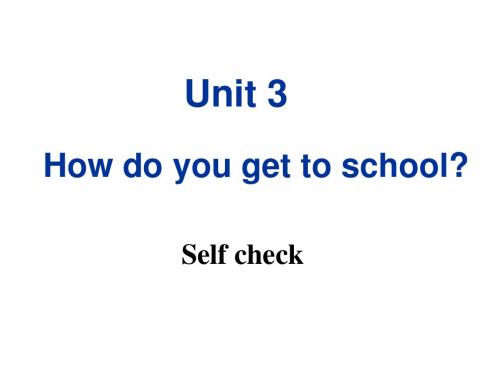
How long does it take John go to work?
Homework
Now your friend is coming to see you from Beijing. But he doesn’t know how to get here and how long it takes. Could you please help him? Write an e-mail to him.
1. It will take you thirty-five minutes by bicycle. 你骑车要花费35分钟。
2. You just take eight stations to go to Wangfujing. 你要坐八站地到王府井。
3. Could you tell me how far it is from here to Guiyou? 请问从这里到贵友大厦有多远?
2. far, the, cinema, is, home, how, from, your, it How far is it your home from the cinema?
3. how, do, the, subway, to, school, go, often, take, you, to How often do you take the subway to go to school?
Unit 3
How do you get to school?
Self check
Role play
A: Can I help you? B: Yes, please. I need to see my friend.
- 1、下载文档前请自行甄别文档内容的完整性,平台不提供额外的编辑、内容补充、找答案等附加服务。
- 2、"仅部分预览"的文档,不可在线预览部分如存在完整性等问题,可反馈申请退款(可完整预览的文档不适用该条件!)。
- 3、如文档侵犯您的权益,请联系客服反馈,我们会尽快为您处理(人工客服工作时间:9:00-18:30)。
Self Check知能新视窗本节学习动词ride, take, live, think of, get to在句子中的应用,在问路和指路的语言材料中学会how far, how long等句型,做一个乐于助人的好学生。
名师开小灶1. Can I help you? 我可以帮助你吗?此句常用于服务场所,在不同的场合译成不同的汉语意思。
如:—Can I help you? 你想买什么?—Yes, please. I want some clothes for my daughter.是的,我想给我的女儿买衣服。
—Can I help you? 你想吃什么?—Yes, please. Some rice and chicken. 是的,来些米饭和鸡肉。
【链接】What can I do for you?也表达同样的意义。
【金钥匙】回答Can I help you?时,作肯定回答常用Yes, please.再说出所需的物品,作否定回答常用No, thanks.。
但回答What can I help you?时,作肯定回答常直接说出所需的物品,这与Can I help you?的肯定回答是不同的。
2. I need to see my friend. 我需要去看我的朋友。
need在此作实义动词,后接动词不定式,表示“需要去做某事”。
如:She needs to go at once. 她需要马上就去。
You don’t need to come if you feel sick. 如果你不舒服就不必来。
【拓展】①need doing意为“某物需要……”,含有被动意味。
如:The TV needs mending again. =The TV needs to be mended again. 这台电视机需要修理一下。
②need作情态动词,没有人称、数和时态的变化,多用于疑问句和否定句,肯定句多用must,have to等,后接动词原形。
如:You needn’t say sorry to me. 你不必向我道歉。
—Need I come now? 我必须现在来吗?—Yes, you must. / No, you needn’t. 是的,你必须来。
/ 不,你不必来。
3. Don’t worry. 别担心。
(1) 这是一个否定的祈使句,用于安慰他人。
(2) 祈使句是用来表达请求、命令、劝告、建议等的句子。
祈使句一般不含主语。
祈使句的否定式一般是在谓语动词前加Don’t。
如:Look at the blackboard. 请看黑板。
Don’t look out. 别朝外看。
(3) worry 作动词,意思是“担心,担忧,焦虑”,后常接介词about。
如:Don’t worry about me. 别担心我。
(4) 形容词为worried,可作表语、定语、补足语等。
常用搭配有:be / look worried, be / look worried about…。
4. Let me look at your map.Let sb. do sth. 意为“让某人做某事”。
如:Let me have a look. 让我看一看。
【拓展】let, make, have都称作使役动词,后面的动作都用动词原形。
如:Don’t make her sleep. 别让她睡着。
She had me stand. 她让我站着。
5. Thank you so much! 十分感谢你!(1) Thank you so much=Thank you very much.其答句有:You’re welcome. / That’s OK. / That’s all right. / Not at all.(2) so作副词,常修饰形容词或副词,意为“如此”。
句中的much是副词。
6. If you have a problem, you can ask me. 如果你有问题,你可以问我。
(1) if引导的条件下状语从句分两种情形:从句使用一般现在时,主句使用情态动词;从句使用一般现在时,主句使用一般将来时。
如:If the traffic light is red, you must stop. 红灯时,你必须停下来。
If he comes tomorrow, I will let you know as soon as possible. 如是他明天来,我会尽快通知你。
(2) problem和question都指问题,但它们有区别,question多指要求回答的问题,或指一般问题,problem则指较难的,或待解决的问题。
如:Can you answer my question? 你能回答我的问题吗?Computers can solve many difficult problems. 电脑可以解决很多难题。
实战演练场夯实基础一、单项选择。
( ) 1. —How does your friend go to school?—________.A. By a bikeB. On bikeC. By bikeD. By his bike( ) 2. —________ is it from your school to the post office?—It’s ten miles.A. How longB. How farC. How awayD. How much( ) 3. —How many _________ are there in an hour?—Sixty.A. daysB. monthsC. yearsD. minutes( ) 4. All the living things ________ on the sun.A. dependB. spendC. lookD. go( ) 5. —_______ are you going to London?—By air.A. HowB. WhenC. WhyD. Where( ) 6. —Can I help you?—________.A. Ye s, I’d love toB. SureC. Yes, pleaseD. I’m sorry you can’t( ) 7. I don’t know the time. May I ______ your watch?A. look atB. seeC. look afterD. read( ) 8. —Thank you _______.—You’re welcome.A. too manyB. too muchC. so manyD. so much( ) 9. I’m afraid I ________ be going away. It’s too late.A. mustB. needC. canD. may( ) 10. —What language do you ________?—English and French.A. sayB. tellC. talkD. speak二、用所给动词的正确形式填空。
1. Tom always ________ (ride) his bike to school.2. Yesterday many students _________ (take) the school bus for a trip.3. Where does your uncle ________ (live)?4. He _______ (have) a quick breakfast and goes to school.5. How long does it take _________ (walk) to the subway station?6. Listen! The birds _________ (sing) in the tree.7. He is new here. He needs _________ (buy) a map of this city.8. ________ (not worry) about me. I can go home.9. Many kids think _______ (play) computer game on Internet is more fun.10. In Japan, the three most popular ways of _______ (get) to school are bus, train and bike.能力提高三、创新设计。
根据所给情景,回答下列问题。
1. How do you go to school?________________________________________________________________2. How far is it from your home to your school?_________________________________________________________________3. How long does it take?_________________________________________________________________4. What do you think of the transportation in your town?_________________________________________________________________5. When you see somebody look worried in the street How do you ask him / her?_________________________________________________________________四、任务型阅读。
根据短文内容,按要求完成下列各题。
In Pakistan most people travel by bus to get from on town to another.①In the less populated parts of the country many journeys take a day and②there is a bus only once or twice a week.③It is a dangerous means of transport and the buses sometimes break down. The roads are often in bad condition and the journeys are very slow and uncomfortable.④It is a good idea to take food and drink because there are not always restaurants or shops on the route (路). The buses are usually very crowded with whole families travelling together.⑤Many people sit on the roof (顶) where it is very hot in the summer and cold in winter.The only advantage (优点) of this means of transport is the cost(价钱). It is very cheap. You only pay for what you get!1. 根据①处句意完成下面的句子。
